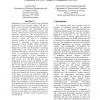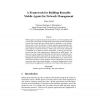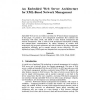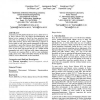DSOM
2000
Springer
14 years 5 months ago
2000
Springer
In recent years, a significant amount of research work has addressed the use of code mobility in network management. In this paper, we introduce first three aspects of code mobilit...
HCW
2000
IEEE
14 years 5 months ago
2000
IEEE
Management of large-scale parallel and distributed applications is an extremely complex task due to factors such as centralized management architectures, lack of coordination and ...
NOMS
2002
IEEE
14 years 5 months ago
2002
IEEE
Mobile agents can migrate among nodes to perform a set of management tasks at each of the visited nodes. Existing mobile agent-based network management systems often assume that t...
NOMS
2002
IEEE
14 years 5 months ago
2002
IEEE
Embedded Web servers are widely used today for IP-based element management. In this paper, we present a new management architecture that combines this technology with XML, DOM, an...
IPPS
2002
IEEE
14 years 5 months ago
2002
IEEE
Conventional network management is based on SNMP and often run in a centralized manner. Although the centralized management approach gives network administrators a flexibility of ...
ICOIN
2003
Springer
14 years 6 months ago
2003
Springer
XML is being used to describe components and applications in a vendor and language neutral. Therefore it already has a role in distributed system. XML is also being used as a data ...
WMASH
2003
ACM
14 years 6 months ago
2003
ACM
A wireless LAN (WLAN)-based Internet service, called NESPOT, of Korea Telecom (KT), the biggest telecommunication and Internet service company in Korea, has been operational since...
INFOCOM
2003
IEEE
14 years 6 months ago
2003
IEEE
—We present an information-theoretic framework for network management for recovery from nonergodic link failures. Building on recent work in the field of network coding, we desc...
SAC
2005
ACM
14 years 6 months ago
2005
ACM
Computing grids require the underlying network infrastructure to be properly configured in order to have appropriate communications among the grids’ nodes. The management of ne...
LCN
2005
IEEE
14 years 6 months ago
2005
IEEE
Generally, current network management technologies follow two approaches: ITU-T’s recommendations for Telecommunication Management Network (TMN) and IETF’s Simple Network Mana...






